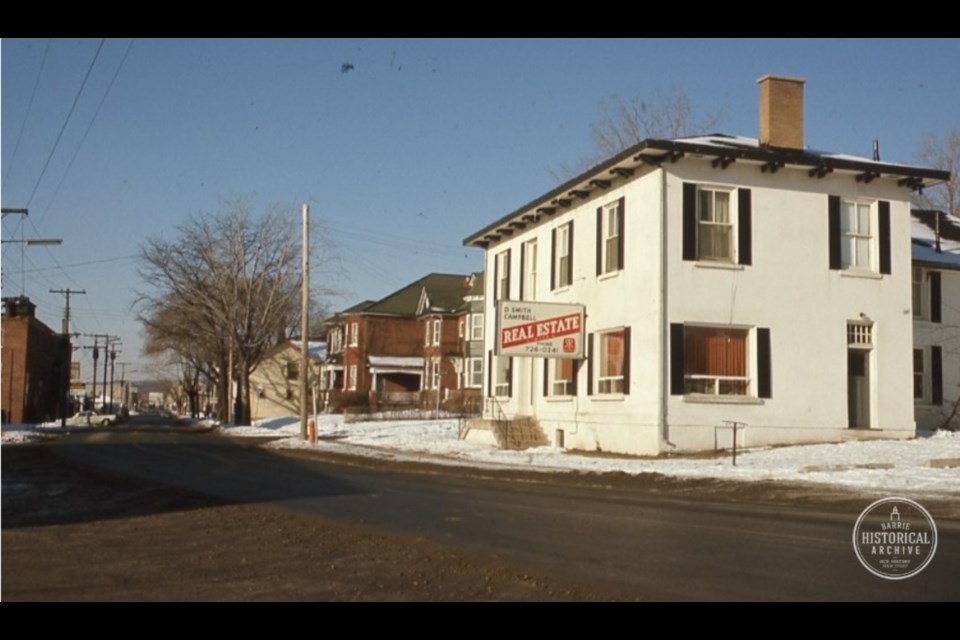This ongoing series from Barrie Historical Archive curator Deb Exel shows old photos from the collection and one from the present day, as well as the story behind them.
Smith-Thomson house (194 Dunlop St. E.)
A gore is an irregular parcel of land, typically triangular shaped, and a gore lot is where we find the Smith-Thomson house or, in more recent times, known as the Harper home.
The home was built in 1842 for Englishman Thomas Smith. An early settler to Barrie prior to 1837, Smith, a blacksmith, had a shop on the opposite side of the street from where his house would be built.
Thomas Ambler, of Birmingham, England, took over Smith’s blacksmith business and is credited with forging the metalwork for the cell doors and other hardware at the county jail.
Solomon Bailey replaced Ambler about 1843. Ambler sold his blacksmith shop on Collier Street to William Povey in 1846. Povey was thought to have worked with wheelwrights George and Richard Whitebread at their establishment at 134 Collier St.
Archibald Thomson resided in this Dunlop Street home. ‘Arch’ Thomson, lumberman, landowner and councilman (1870), was a member of one of Barrie’s first families. He and his family lived in Angus, where he ran a lumber business for about 15 years, before moving to Barrie. His large tracts of timber stood where the village of Angus would later be built.
Thomson owned a large piece of land west of Bayfield Street, between Elizabeth (now Dunlop) and Wellington streets, known as the former Eccles property. He built a large home there, overlooking the six acres of land he would offer to the Town of Barrie in 1867 for municipal use as well as a location for a drill shed. We know this space now as Queen’s Park.
Thomson sold the Dunlop Street property to the Harper family about 1884.
Born in 1842, of Irish descent, Henry Harper was an Innisfil pioneer. In the village of Cookstown, Harper, in 1866, was postmaster, a general merchant and a druggist, but also known to issue marriage licences.
By 1872, he was a bookseller, an appraiser and a member of the Canada Permanent Building and Savings Society. Moving to Barrie in 1880 with wife Margaret and five of their six children — Emma, Willie, Laura, Bert and Frank (James had left home by then) — his occupation was listed as insurance agent.
The Harpers were said to be kind and affectionate parents, sacrificing personal and social pleasures to provide for their children. Deeply devoted to each other and their faith, the Harpers extended a similar enduring love and genuine support to their family.
Tragically, this loving and inspirational couple died of pneumonia within six days of each other in the spring of 1900.
Tragedy struck this close family again when son Bert died the following year trying to rescue a young woman who fell through the ice on the Ottawa River during a skating party hosted by the governor general, Lord Minto. Harper and his friend, Bessie Blair, daughter of A.G. Blair, minister of railways, drowned.
Bert, who graduated from the University of Toronto, was considered a brilliant journalist and highly respected in the industry, particularly with regard to his writings on political and social conditions.
Prior to the accident, Harper had resigned from his newspaper job in 1900 to work for Mackenzie King, his Ottawa roommate, as the assistant editor of the Labour Gazette, Wilfrid Laurier’s Department of Labour’s main publication.
To honour his dear friend and hero, King commissioned a sculpture of Sir Galahad placed outside the Parliament buildings, unveiled in 1905. In front of the main entrance to Parliament Hill, it is the only statue not portraying a monarch or politician. King published a book about his friend, The Secret of Heroism, in 1906.
Locally, there was discussion of a plaque to be placed at Barrie Collegiate Institute, where Harper attended school, or at the Presbyterian church.
Emma Harper, the eldest daughter of Henry and Margaret, was a bright and friendly young woman, known for her kind-heartedness and hard work at St. Andrew’s Presbyterian Church, where she taught the primary class for many years.
In 1902, she married Donald Ross in a small but elegant wedding at her cousin’s home in Toronto. Donald presented his bride with an exquisite brooch of diamonds and pearls.
Following a honeymoon in New York, Boston and other cities, the couple returned to Barrie, settling just down the street from her family home, at 168 Dunlop St. E.
In just a few years, her young husband was elected mayor of Barrie and would go on to serve the community in many ways for many years.
In the fall of 1903, the Harper home was offered for sale. The brick house featured modern conveniences, a furnace, a garden with fruit trees, a brick stable and a pleasant view of the bay.
Alfred Beardsley appears as the owner of the Harper house in 1907.
Alfred was the son of John Beardsley and Sarah McKernan. Sarah, born in Ireland, and a resident of Barrie since 1832, married John in 1837, when he was deputy sheriff of the district.
In 1843, John, who had once practised law in the United Kingdom, became the caretaker of the county courthouse until he died in 1848.
When John died, Sarah replaced him as caretaker, a position she held for more than 50 years. Shortly before Sarah’s death, county council appointed her daughter, Carolina, as successor.
Alfred, too, lived most of his life serving the county. In fact, records indicate he had been born in the courthouse. Working on courthouse hill seemed to be a family affair — Alfred’s brother, John, was employed there, too, as a county messenger.
When John Jr. died, his brother, Alfred, was appointed county messenger in 1885. Alfred was also appointed county detective in 1891 and high constable of the county in 1896. As a longtime messenger, Alfred acted as deputy clerk as well.
From 1905 until 1910, Beardsley was a member of town council and chair of the finance committee in 1910. Both Alfred and his sister worked at the courthouse until the early 1920s.
The Harper house passed from Caroline Beardsley to the next owner in 1913. The Beardsley children ended up living right across from the courthouse at 121 Worsley St.
The oldest part of the simple Georgian-style dwelling at 194 Dunlop St. E. is said to be the first brick house built in Barrie. Balconies and porches have been added and removed over the years, brick was covered with stucco, and then siding, but the historic home still has its pleasant view of the bay.




